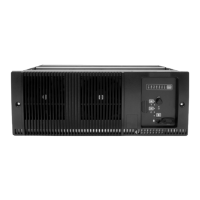120 Technical Description TB9100/P25 CG/P25 TAG Installation and Operation Manual
© Tait Limited March 2014
The VCO is phase-locked to the frequency reference via the synthesizer.
The output from the VCO passes through the VCO buffer to the exciter
amplifier, which increases the RF signal to +20dBm. This signal is then
attenuated through a pad to +11 dBm. An 8VDC PA Key signal is mixed in
with the RF signal which is then fed to the PA.
Digital Board The IF from the receiver RF circuitry is passed through an ADC and DDC
(digital down-converter) to the digital board DSP. Incoming audio from the
network, analog line or microphone is passed to the exciter RF circuitry via
the DSP and CODECs.
The main control elements on the digital board are the RISC processor and
the DSP. Communication between the two takes place via a host port
interface.
The digital board RISC is responsible for the following:
■ initializing and supervising the digital board DSP
■ controlling the Tx key, Rx gate and PA key
■ monitoring the maintainer’s access via the control panel microphone.
The digital board DSP operates under the control of the RISC to provide a
number of functions, including:
■ demodulating incoming FM signal and identifying whether it is P25
digital or analog FM
■ modulating an RF signal from a P25 digital or analog FM signal received
from the network, analog line or microphone
■ implementing the control panel interface: transmitting and receiving
speech samples to and from the network board DSP
■ generating NAC, CTCSS and DCS
■ generating the signal quality information RSSI and SINAD.
Network Board The network board provides the links between the digital circuitry and the
Tait P25 Network. This board is securely mounted to the reciter’s chassis and
is connected to the digital board by a 40-way flexible connector and a PCB
connector. The network board provides the base station with an identity as
a network element.
The network board has a DSP and a RISC processor. The RISC provides
the main control functions of the board. It communicates with the DSP via
a host port interface.
The network DSP provides a number of functions, including:
■ performing forward error correction (FEC) encode/decode on P25
signal to/from the RF interface
■ encoding P25 digital signals into IMBE speech packets
■ encoding analog FM signals into G.711 speech packets

